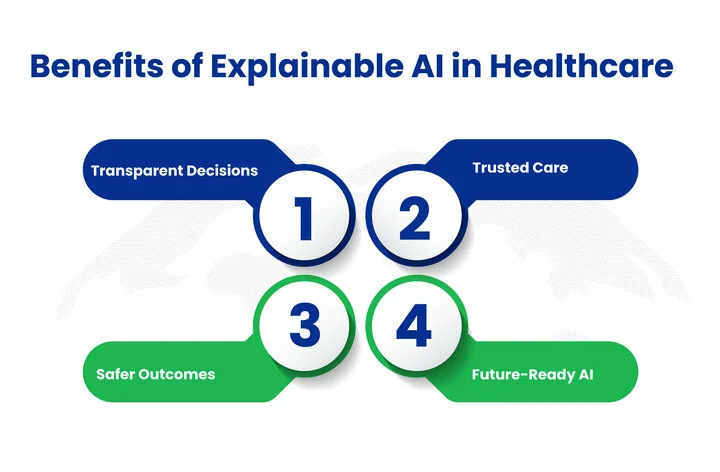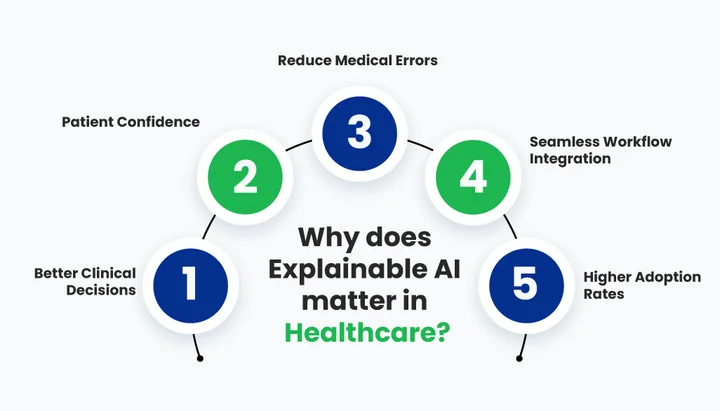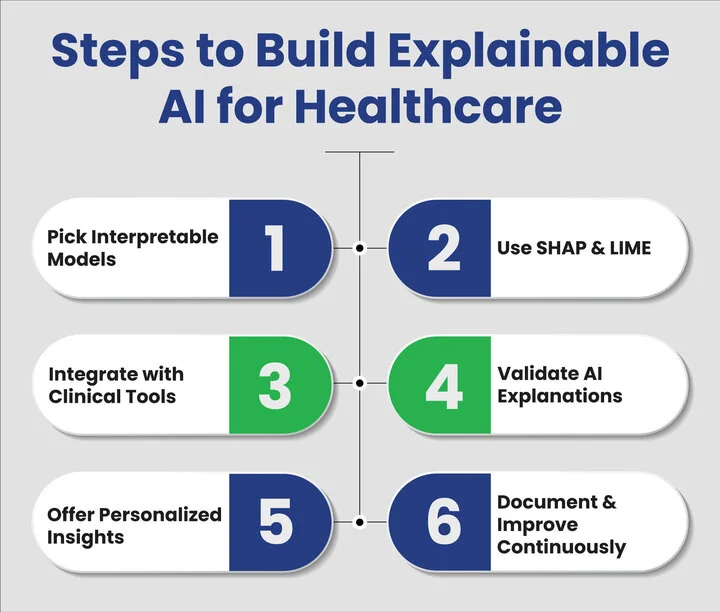Can you trust AI to make life-or-death healthcare decisions if you don’t understand how it works?
This is a challenge many doctors face today. AI can analyze vast amounts of patient data and suggest treatments faster than ever, but when its reasoning is unclear, trust becomes a significant concern.
In fact, an HIMSS report shows that 86% of healthcare organizations use AI, yet 72% remain concerned about its transparency and explainability. This gap between adoption and trust highlights the urgent need for AI systems that are not just smart but also understandable and reliable.
This is where Explainable AI (XAI) comes in. XAI is changing the way clinicians approach diagnosis, treatment recommendations, and patient care by making AI predictions transparent, actionable, and reliable.
In this blog, we’ll explore why XAI in healthcare matters, how it builds trust, and practical steps for creating AI systems that clinicians can rely on confidently.
So, let’s jump in to understand why XAI is no longer optional but essential!
What is Explainable AI (XAI) in Healthcare?
Explainable AI, or XAI, refers to AI systems designed to make their decisions clear and understandable to humans. In healthcare, this means that clinicians can see precisely how an AI model reaches its conclusions, whether it predicts disease risk, suggests treatments, or analyzes patient data.
Transparency is essential because medical decisions directly affect patient outcomes, and understanding AI reasoning helps build confidence in its use.
Table of Contents
Furthermore, XAI addresses a significant limitation of traditional AI models, often called “black boxes,” which provide predictions without revealing how they were derived. Unlike opaque systems, XAI highlights the factors contributing to each decision.

For example:
- It can show which lab results or imaging findings most influenced a diagnosis.
- It identifies patterns in patient history that affect treatment recommendations.
- It provides explanations in a format that clinicians can interpret and verify.
Additionally, interpretable machine learning in medicine improves collaboration between AI systems and healthcare professionals.
When doctors understand the reasoning behind AI predictions, they can make more informed decisions, reduce errors, and communicate recommendations effectively to patients.
However, XAI turns AI from a mysterious tool into a helpful healthcare partner by focusing on interpretability and clarity, enabling healthcare providers to provide safer, more informed, and individualized care.
Building such transparent systems often starts with a well-structured artificial intelligence development service that focuses on model interpretability and responsible data use.
Finding it hard to trust AI for life-critical healthcare decisions? Explainable AI clarifies predictions, helping clinicians make confident, data-driven decisions.
Why Does Explainable AI Matter in Healthcare?
Explainable AI in healthcare plays a vital role in ensuring AI decisions are transparent and actionable for medical professionals. It transforms AI outputs from abstract predictions into interpretable insights that support clinical practice.
XAI is essential in healthcare for the following principal reasons:

1. Improved Clinical Decision-Making and AI Support Systems
XAI shows doctors exactly which patient data influenced predictions, enabling them to validate AI outputs and combine insights with their expertise for more accurate diagnoses and treatment plans.
This clarity also strengthens clinical decision support systems in hospitals, making AI tools easier to integrate into daily workflows.
2. Increased Patient Trust
Patients are more likely to follow recommendations when the rationale is visible. Trustworthy AI in healthcare ensures patients feel confident in AI-assisted care.
3. Error Identification and Risk Reduction
Healthcare AI transparency enables professionals to detect anomalies or inconsistencies in AI predictions. This reduces misdiagnosis and improves patient safety.
4. Better Adoption and Integration
Models that clearly explain their reasoning are more likely to be adopted in real-world healthcare settings. Benefits of interpretable machine learning in healthcare include improved workflow efficiency and higher acceptance by medical teams.
Additionally, XAI helps healthcare professionals make informed, confident decisions while maintaining accountability. Its ability to provide clarity, reliability, and actionable insights makes it an essential part of modern medical AI systems.
Now, let’s discuss how to develop Explainable AI!
How to Build Explainable AI in Healthcare?
Building explainable AI in healthcare is about creating systems that clinicians can understand, trust, and use confidently to make decisions. Transparent AI not only strengthens patient safety but also enables medical teams to act effectively on predictions.
Organizations can create such solutions by collaborating with healthcare software development experts who ensure models meet clinical and regulatory standards.
The following practices outline how healthcare organizations can build AI models that are both powerful and understandable:

Step 1: Pick Interpretable Models
The first step in building explainable AI in healthcare is selecting inherently interpretable models. This ensures clinicians can understand how predictions are made and integrate insights confidently into patient care.
Essential features of interpretable models consist of:
- Decision Trees: Show how different patient factors lead to specific outcomes.
- Linear Models: Explain relationships between input data and predictions.
- Rule-Based Systems: Provide clear if-then rules that clinicians can follow.
Additionally, starting with interpretable models lays a strong foundation for advanced techniques such as SHAP and LIME in healthcare, thereby improving transparency and trust in AI systems.
Step 2: Implement SHAP and LIME for Model Interpretability
Once interpretable models are chosen, the next step is to apply SHAP and LIME in healthcare to explain how AI predictions are generated. These tools provide insights into which features most influence outcomes, making explainable AI in healthcare actionable for clinicians.
The primary uses include:
- SHAP: Assigns contribution scores to each feature, helping clinicians understand patient-specific predictions.
- LIME: Highlights local explanations for individual cases, showing which factors affected a particular decision.
- Practical Use: For instance, identifying how blood pressure, cholesterol, or imaging results impact disease risk predictions.
Additionally, these techniques strengthen AI model interpretability, fostering trust and supporting safer clinical decisions.
Step 3: Integrate XAI into Clinical Workflows
After making AI predictions interpretable, the next step is to integrate explainable AI into everyday clinical workflows in healthcare. This ensures clinicians can access explanations alongside recommendations, making AI insights actionable.
The primary methods of integration are:
- Embedding in Clinical Decision Support Systems: Provide AI explanations directly within the tools doctors use.
- Real-Time Access: Allow clinicians to see which patient features influenced predictions in real time.
- Practical Example: Highlighting lab results, imaging data, or vital signs that contributed to a treatment suggestion.
Additionally, seamless integration strengthens AI model interpretability, boosts decision-making, and builds trust among healthcare teams.
Step 4: Validate and Test Model Explanations
Validating and testing AI explanations is essential to ensure that explainable AI in healthcare provides reliable, trustworthy insights. This step confirms that predictions align with clinical reasoning and support safe decision-making.
The validation strategies include:
- Cross-Checking Predictions: Compare AI outputs with clinical guidelines and expert judgment.
- Simulation Testing: Evaluate model performance across different patient scenarios to ensure consistency.
- Practical Example: Verifying that a model correctly predicts cardiovascular risk highlights contributing factors such as cholesterol, blood pressure, and family history.
Additionally, consistent validation improves AI model interpretability and strengthens trust among clinicians and patients.
Step 5: Provide Individualized Insights
Health monitoring with AI is another significant advantage of XAI. Interpretable AI models can generate patient-specific insights, making explainable AI in healthcare more actionable and relevant. Understanding individual factors helps clinicians tailor treatment plans and improve outcomes.
Practical strategies for personalized insights include:
- Patient-Specific Feature Analysis: Identify data points, such as lab results or lifestyle factors.
- Targeted Recommendations: Use these insights to guide personalized interventions, like adjusting medication or suggesting lifestyle changes.
- Practical Example: Highlighting that elevated cholesterol and family history contributed most to a patient’s cardiovascular risk.
Additionally, individual insights improve the trustworthiness of AI in healthcare by providing clear reasoning for each patient’s treatment plan.
Step 6: Document, Communicate, and Continuously Improve
Maintaining documentation and refining XAI in healthcare models ensures transparency and accountability. Clear communication improves clinician and patient confidence while supporting AI ethics in healthcare.
The Best practices include:
- Document Decisions: Keep logs of AI reasoning and outputs to enable clinical review.
- Communicate Clearly: Provide explanations in an accessible format so medical staff and patients understand AI recommendations.
- Collect Feedback: Use clinician and patient input to refine models and improve transparency continuously.
- Practical Example: Updating the system to better highlight relevant lab results based on clinician feedback improves accuracy and trust.
Additionally, this step ensures explainable AI in healthcare evolves to meet real-world needs and supports safer, more effective care.
Frequently Asked Questions (FAQs)
2. How Can Explainable AI be Implemented in Medical Diagnostics?
To implement XAI in medical diagnostics, healthcare organizations can integrate interpretable models and visualization tools into diagnostic workflows. Techniques like SHAP and LIME explain which features contributed most to a diagnosis, while decision trees and rule-based systems provide easy-to-follow logic paths. Embedding these tools in clinical software allows radiologists, pathologists, and physicians to see the reasoning behind every diagnostic suggestion in real time.
3. How Does Explainable AI Help Build Trust in AI-driven Healthcare Systems?
Trust comes from clarity and consistency. XAI builds trust by making AI’s reasoning transparent. When AI models explain their logic clearly, clinicians can validate results, patients can see the rationale behind care recommendations, and organizations can maintain accountability. This shared understanding creates confidence in AI-assisted healthcare.
4. What are the Main Challenges in Achieving AI Transparency in Healthcare?
Achieving AI transparency isn’t always straightforward. Common challenges include:
- The complexity of deep learning models is often difficult to interpret.
- Data privacy regulations limit how patient data can be used or disclosed.
- Balancing interpretability and accuracy, as simpler models may be easier to explain but less precise.
- The lack of standardized frameworks makes it harder to evaluate and compare explainability across systems.
Overcoming these challenges requires combining technical innovation with ethical and regulatory best practices.
5. What Steps Can Healthcare Organizations Take to Make AI More Explainable?
Healthcare organizations can promote explainability by:
- Choosing interpretable model architectures like decision trees or linear models.
- Applying post-hoc explainability methods (e.g., SHAP, LIME) to clarify predictions.
- Integrating XAI tools into clinical workflows for real-time insights.
- Validating explanations through clinician review and patient feedback.
- Continuously improving AI systems by documenting decisions and refining models over time.
These steps ensure AI systems remain transparent, trustworthy, and aligned with clinical needs.
Conclusion: The Impact of Explainable AI in Healthcare
Explainable AI in healthcare has made a significant impact on doctors and medical teams. One big challenge is ensuring AI predictions are not only accurate but also clear and easy to understand. Without this transparency, even the smartest AI can feel like a black box, making it hard for clinicians to fully trust it.
The good news?
Working with AI consulting services can guide healthcare organizations to implement AI solutions that are transparent, reliable, and actionable. This means doctors can see exactly why a prediction is made, make confident decisions, and provide patients with care they trust.
In the end, adopting explainable AI today sets the stage for the future. With proper support, healthcare teams can build scalable, safe, and ethical systems that improve patient outcomes and make everyday clinical work more innovative and more efficient.
Bring transparency to your healthcare AI systems with expert development support that builds trust and reliability.








Share your thoughts about this blog!